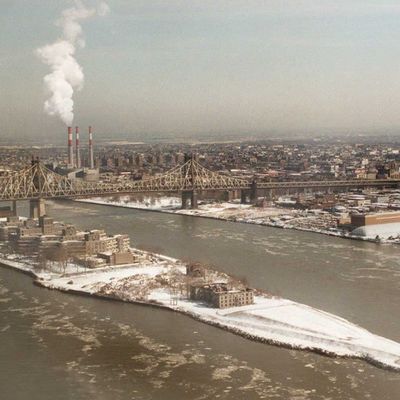
In case Cornell’s plan to build a high-tech research center on Roosevelt Island left any doubt about the rural university’s urban ambitions, the selection of Thom Mayne and his Los Angeles–based firm Morphosis to design the campus’ anchor building makes it clear that the school’s thinking is bold as well as big. The structure — and, eventually, the whole campus — will be as prominent on the East River’s skyline as the Pepsi-Cola sign, an icon of the city’s postindustrial intellectual economy. And while Mayne has no idea what form it will take, what he has in mind is not just a box full of classrooms, but architecture that plays an urban role.
This project, he says, “challenges the ivory towerness of the campus and embeds it into the city.” That’s a crucial part of the whole rationale: to send sparks of invention leaping across the river, from the new campus to the medical complexes of Manhattan’s East Side and to startup ventures in Long Island City.
The $100 million that the Bloomberg administration has promised to plow into the project should buy a design that helps knit Roosevelt Island into the heart of the city. That won’t be easy. On a map of New York, the island looks like it could be the city’s throbbing heart, but it’s really a blank in the middle of its consciousness. To the island’s 12,000 residents, it is a quiet high-rise village in the middle of the East River. To location scouts, it’s a picturesquely ominous setting for rendezvous between detective and informant, with midtown rearing alluringly beyond. The rest of us know it mostly for the cable car and the gothic ruin of the Smallpox Hospital — or as the resting place of beer cans tossed from the Queensboro Bridge.
The word “isle” gives us “isolation,” and the site is bounded by water on two sides, a park to the south, and the bridge to the north. Getting on and off the new campus will likely remain a chore; the small population of scientists and engineers probably won’t be numerous enough to justify a new footbridge, or even ferry service. Mayne tries to skate over that problem by describing the site’s “isolated connectedness.”
For now, he’s focused on the challenge of conceiving a place where geniuses can hang out and swap eurekas. Mayne has plenty of experience building for rarefied thinkers: the curvy lockbox of Cooper Union, an astrophysics building for Cal Tech, a satellite control center in suburban Maryland, where a great steel truss, bristling with dishes, hovers over an underground office complex. He is not a delicate designer. His buildings impose themselves on the landscape, inciting more admiration than tenderness. They are as tough as the problems that people inside are trying to solve.
But whatever shape and size Mayne and his upstate clients choose for the inaugural building, it will need to feel like an integral part of New York. The architect has not yet scrutinized Skidmore Owings and Merrill rather stolid master plan, in which blocky buildings are sprinkled, suburban-style, across an open green. But Mayne dangles the possibility that he will meddle with that scheme rather than take it as a set of givens. He starts daydreaming about a building that doubles as a bridge. “You could sling a piece across the river on one side towards Manhattan and it would open all kinds of fantastic possibilities for linkages.”
Even if that particular idea never gets farther than a paper-napkin sketch, Cornell should support that kind of fantasy as a counterpart to the technological creativity the school hopes to foster. Otherwise, the university might march out of the ivory tower, only to hole up in a subsidized island redoubt.






























